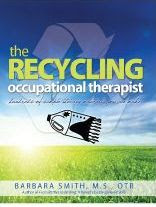I recently had the pleasure of hearing
Dr. Jed Baker speak at a Future Horizons conference- where he shared many of
the same concrete and logical strategies he describes in his book- No More Meltdowns. I recommend attending
one of his presentations to fully appreciate his wisdom, experience and humor.
Carol Stock Kranowitz, author of The Out- of- Sync Child wrote the
foreword to this book because as an educator she recognizes the critical role
of sensory-based strategies as part of the four-step program to prevent incessant
meltdowns. As an occupational therapist, I too appreciate how Dr. Baker explores
the child’s sensory challenges when evaluating behavioral triggers and
implementing interventions. For example, a child ran away from a
school staircase because the reverberation was aversive to his auditory
sensory system. An effective intervention such as using the staircase at a
quieter time could only be implemented after identifying this sensory-based trigger.
Dr. Baker’s book begins with a
detailed explanation as to what exactly a “meltdown” is- an escalating negative emotional reaction. Parents of children who respond
to the common methods of consistent rules and consequences- don’t need to read
this book! However, when rewards and
punishment no longer work and actually escalate the power struggle -it is time
to look at Dr. Baker’s 4-step program. This involves:
·
Accepting and appreciating
your child
·
De-escalating a meltdown
·
Understanding why a
meltdown keeps occurring
·
Creating plans to prevent
meltdowns
Readers learn how factors-such as an
overactive emotional center, sensory processing disorder or difficulties with
abstract thinking interfere with the development of self-control. Dr. Baker provides
many strategies but here are a few of my favorites:
 1) use the 80/20 % rule-this means
that since kiddos who have learning and behavioral challenges have a history of
failure, spend 80% of the time with activities, including school work that
we know will be successful and 20% of the time introducing new material.
1) use the 80/20 % rule-this means
that since kiddos who have learning and behavioral challenges have a history of
failure, spend 80% of the time with activities, including school work that
we know will be successful and 20% of the time introducing new material.
2) children who are in the middle of a "melt down" cannot respond to
logic.
Since their out of control behavior is escalating - they are best managed
by.....
*distraction,
*sensory interventions such as jumping into a crash pad,
*enhancing communication (i.e. pictures, Ipad)
*and handling our own feelings during the crisis.
3) strive to prevent meltdowns in the first place by recognizing that:
*fear of failure leads to anger
*one size solutions do not fit all
* punishment works, but we pay a big (negative) price for it, and
* misbehavior is often unintentional.
Dr. Baker states this simple rule: REWARD EFFORT, NOT OUTCOME!
This is also my Occupational therapy mantra as I strive to create fun, therapeutic
activities that meet a child’s sensory needs with just enough cognitive
challenge to be interesting, assure success and build self-esteem. Using
sensory modalities, visual supports, tweaking the difficulty level, even the time
of day tasks are given and providing a reward system may all be included in the
OT and psychologist’s bag of tricks. Now readers, especially parents have the
positive interdisciplinary tools spelled out for them in No More Meltdowns.
I recommend that you jump, skip and crawl through a cloth tunnel to get to read
this book or get to Dr. Baker’s next presentation. You will be richly rewarded!


















